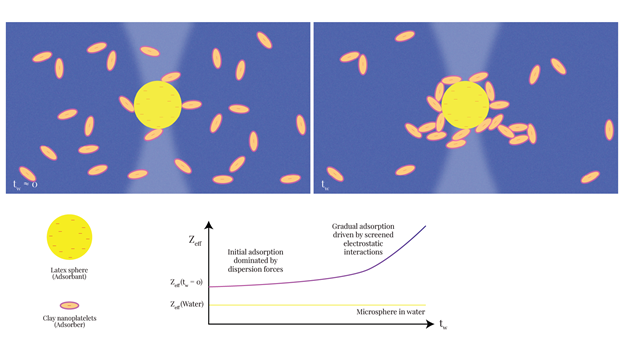Researchers have recently shown that using optical tweezer electrophoresis can help us understand how particles stick to surfaces at tiny scales, at shorter time-scales, a phenomenon that is used in applications ranging from coating to water purification.
The adsorption phenomenon is exploited in the industry for coating a product and refers to the adhesion of one material onto the surface of a different material. This phenomenon is also used in water purification to remove pollutants and for colloidal stabilization during the synthesis of food emulsions. Usually, adsorption is detected via changes in mass or volume.
Researchers from the Raman Research Institute, an autonomous institute funded by the Department of Science and Technology (DST), Government of India, studied adsorption by using Laponite clay nanoplatelets (adsorbate) and Latex spheres (adsorbent) to understand how individual particles are adsorbed.
They used optical tweezer electrophoresis, a technique that tracks changes in electrical charge on the adsorbent. The technique of manipulating a micron-sized object using light is known as optical tweezer and was awarded the Nobel prize in Physics in 2018. The researchers exploited the optical force exerted by a focused laser beam to grab a micron-sized Latex particle suspended in a clay-water mixture.
The researchers then applied an electric field across a clay-water mixture and tracked the movement of the trapped Latex sphere at an extremely fast rate of 30,000 measurements/ second. The adsorption of clay particles transfers charges to the trapped microsphere.
The researchers tracked the change in the effective charges on the trapped sphere due to adsorption. The fast temporal resolution of these measurements allowed monitoring of adsorption events as they occurred, enhancing the understanding of dynamic interactions, and providing a better basis for the study of adsorption mechanisms. These measurements provided insights into the rate and extent of nanoplatelet adsorption. The results published in Soft Matter, the journal of the Royal Society of Chemistry indicated that higher Laponite concentrations accelerated the adsorption process due to increased nanoplatelet availability.
As a quantitative correlative test, the researchers used cryogenic-field emission scanning electron microscopy (cryo-FESEM) to observe the patterns of adsorption of the clay more clearly and to gain a better understanding of the mechanisms of clay adsorption. Cryo-FESEM images of Latex microspheres suspended in water revealed smooth surface textures, indicating no significant adsorption in pure water. However, when the microspheres were immersed in water- clay mixtures, the clay particles adhered onto the microsphere, displaying patches corresponding to clay nanoplatelets.
The size distribution histograms of these patches showed ranges close to 50 and 25 nm, corresponding to small clay aggregates and individual nanoplatelets. The researchers controlled the adsorption process by tuning the interparticle interactions between clay nanoplatelets and Latex sphere using additives, such as common salt and a peptizing agent. They were able to separate the roles of two attractive forces, dispersion and electrostatic, in the adsorption process and noted that optical tweezer based single colloid electrophoresis and cryogenic field emission scanning electron microscopy are reliable, complementary measurements to study adsorption processes.
“The use of optical tweezer-based single-colloid electrophoresis enables real-time tracking of nanoplatelet adsorption on a single particle and enables us to gain insights that were previously inaccessible through other techniques. While electron microscopy provides detailed visualization of the adsorbed particles, it cannot capture the adsorption kinetics. We used electron microscopy to validate our findings,” the first author Vaibhav Raj Singh Parmar, a PhD student at the Raman Research Institute, explained.

Fig 1. Schematic representation of the mechanisms governing the adsorption process of clay nanoplatelets on a Latex microsphere.
The researchers identified non-electrostatic dispersion interactions as the dominant mechanism driving initial nanoplatelet adsorption. At higher clay and ionic concentrations, electrostatic screening accelerated the adsorption of nanoplatelets, aggregates, and gel network strands. These findings provide valuable insights into the adsorption behaviour of clay nanoplatelets and their interactions with colloidal surfaces in different ionic environments.
Prof. Ranjini Bandyopadhyay, lead of RRI’s RheoDLS lab, pointed out, “Our next goal is to enhance the precision of our measurements by integrating optical tweezer electrophoresis with advanced microfluidic techniques. We are currently developing a holographic optical tweezer capable of trapping multiple beads simultaneously, which will enable us to investigate medium-mediated charge transfer between beads made of the same or different materials”.
Such an understanding of adsorption dynamics at small spatial and temporal scales can help industries to gain precise control over the adsorption process, especially in charged materials.
Link to publication: https://doi.org/10.1039/D4SM01319K
For any queries, please contact us on outreach[at]rrimail[dot]rri[dot]res[dot]in






























